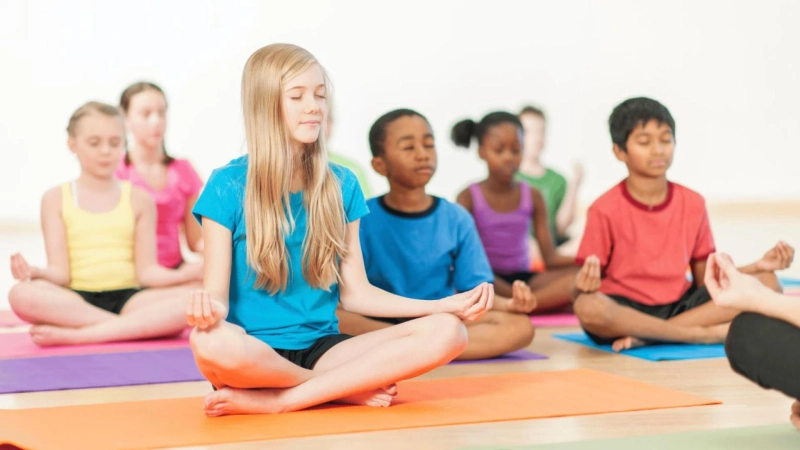It's well known that yoga is beneficial for grownups. And millions of people do this frequently all throughout the world. But is yoga just for grownups? No! Yoga should ideally be practiced from an early age so that children can develop into all-rounded individuals and do not later turn to yoga to address physical and mental problems. The yoga classes for kids can give life-long advantages. In fact, the right age to start the practice is eight.
It is well known that individuals deal with stress every day in a variety of ways. But children too nowadays are exposed to stress at par with adults. In addition to dealing with peer pressure and the challenging stage of puberty, they must also maintain their involvement in extracurricular activities while living up to the expectations of their parents and teachers. This is a lot to handle for a young child.
In this digital age, there are a number of benefits of yoga for kids online as well. The body and its supporting systems, such as the neurological, respiratory, and digestive systems, are greatly impacted by the practice. Children's emotions and conduct are influenced by yoga, which also improves mental health and fosters creativity.
The mind goes through various phases. Although many people think that children can be hard to influence, some of them are actually highly open. The "quality of awareness" can be altered with the aid of yoga. The quality of consciousness is excellent when one is alert and receptive, and it is bad when one is easily distracted, has trouble focusing, absorbing information, has trouble remembering things, or has a poor memory.
When should children begin yoga? In India, children are usually initiated into religious activities at the age of eight in a ceremony called an upanayanam. Children of this age are first introduced to the gayatri mantra, nadi shodhana pranayama, and sun salutations. This is the essential turning point in a child's physical and psychological development as they prepare to become adults.
At the age of 8, the lungs' air sac count stabilizes and is considered the best time to start doing pranayama. The cardiovascular and respiratory systems get high level of endurance and resistance.
By the age of eight, learning sun salutations and nadi shodhana pranayama helps as it stabilizes the immune system.
Pineal gland decides the level of awareness in a kid. Practicing yoga from the age of eight can postpone puberty, extending their childhood. This will benefit them to better handle the physiological, psychological, and emotional challenges of puberty. It has also been discovered that children who enter puberty a bit later grow up to be more perceptive, sensitive, and bright than those who enter puberty earlier.
At around eight years of age, spiritual development starts. Children should be introduced to karma yoga at this time so they may start helping with simple home chores, gain responsibility, develop values, and be held accountable.
Basic Rules of Teaching Yoga for Kids
Build up your kids' practice gradually. To perfect the yoga poses, they need practice. Take your children to the next level once they have gotten used to the taught stances. Keep an eye on and direct your kids during this procedure.Make sure that your initial sessions are brief. Complete your yoga classes quickly. This is a result of kids' limited attention spans. Increase the time after they are comfortable with their sessions.Pay attention to your breathing. Teach your kids how to breathe properly and deeply. It aids in their relaxation and composure.Don't pressure your kids to achieve perfection. Instead of stressing perfection, yoga for kids should emphasise achieving decent poses and discovering new things.Practice yoga positions before assisting your kids. Participate yourself in their method. Your kids will be able to mimic and follow your poses more readily.Make use of visual aids like illustrations, photographs, or even yoga pose videos. Show your children each of the pictures in person or pin them on a board. Prior to yoga positions, do this. This will help your kids follow you and visualise what you're doing.The yoga mats and pillows will be good to designate separate areas for your kids. Your kids can use these marked areas, but they must also be considerate of their younger sibling's space. This teaches them from a young age to respect boundaries and adhere to regulations.Kids' yoga requires music. Play it as you do yoga. Children can become energized or calmed by music. Make the most of the music selection.Practice yoga regularly. Encourage your kids to practice the energizing yoga positions in the morning. They should practice relaxing yoga positions at night to get to sleep quickly. Adapt it to your children's behavior.Bottom line
Yoga may undoubtedly help kids develop and thrive. But experts don't suggest that we force our kids to practice yoga from the moment they can walk. But when the time is appropriate, they urge you to look for a yoga instructor who can help introduce your child to the practice. Giving a child this gift gives them confidence. The future of the world planet depends on small children so they need to be spiritualized as much as they should grow physically strong.


